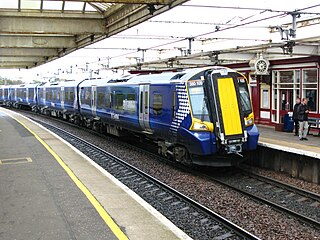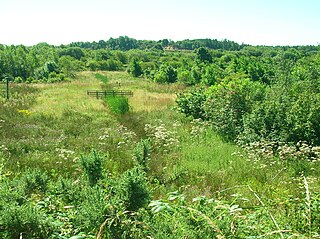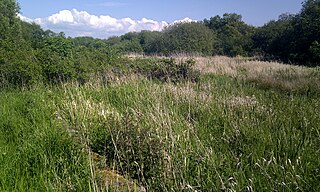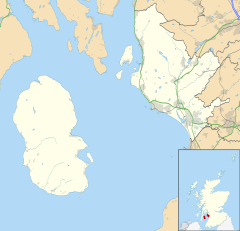
Ayrshire is a historic county and registration county, in south-west Scotland, located on the shores of the Firth of Clyde. The lieutenancy area of Ayrshire and Arran covers the entirety of the historic county as well as the island of Arran, formerly part of the historic county of Buteshire. Its principal towns include Ayr, Kilmarnock and Irvine and it borders the counties of Renfrewshire and Lanarkshire to the north-east, Dumfriesshire to the south-east, and Kirkcudbrightshire and Wigtownshire to the south. Like many other counties of Scotland, it currently has no administrative function, instead being sub-divided into the council areas of East Ayrshire, North Ayrshire and South Ayrshire. It has a population of approximately 366,800.

North Ayrshire is one of 32 council areas in Scotland. The council area borders Inverclyde to the north, Renfrewshire and East Renfrewshire to the northeast, and East Ayrshire and South Ayrshire to the east and south respectively. The local authority is North Ayrshire Council, formed in 1996 with the same boundaries as the district of Cunninghame which existed from 1975 to 1996.

Cunninghame is a former comital district of Scotland and also a district of the Strathclyde Region from 1975 to 1996.
Campbell Martin is a Scottish journalist and former politician.

The Ayrshire Coast Line is one of the lines within the Strathclyde suburban rail network in Scotland. It has 26 stations and connects the Ayrshire coast to Glasgow. There are three branches, to Largs, Ardrossan Harbour and Ayr, all running into the high level at Glasgow Central.

Ardrossan is a town on the North Ayrshire coast in southwestern Scotland. The town has a population of 10,670 and forms part of a conurbation with Saltcoats and Stevenston known as the 'Three Towns'. Ardrossan is located on the east shore of the Firth of Clyde.

Stevenston is a town and parish in North Ayrshire, Scotland. Along with Ardrossan and Saltcoats it is one of the "Three Towns", all of similar size, on the Firth of Clyde coast; the easternmost parts of Stevenston are about 1⁄2 mile from western parts of Kilwinning, the A78 trunk road runs between the settlements.

North Ayrshire and Arran is a constituency of the British House of Commons, located in the south-west of Scotland within the North Ayrshire council area. It elects one Member of Parliament (MP) at least once every five years using the first-past-the-post voting system of voting.

West Kilbride is a village and historic parish in North Ayrshire, Scotland, on the west coast by the Firth of Clyde, looking across the Firth of Clyde to Goat Fell and the Isle of Arran. West Kilbride and adjoining districts of Seamill and Portencross are generally considered to be a small town, having a combined population of 4,393 at the 2001 census.
Bute and Northern Ayrshire was a county constituency of the House of Commons of the Parliament of the United Kingdom from 1918 to 1983. It elected one Member of Parliament (MP) by the first past the post voting system.

Cunninghame North is a constituency of the Scottish Parliament (Holyrood) covering part of the council area of North Ayrshire. It elects one Member of the Scottish Parliament (MSP) by the first past the post method of election. It is also one of ten constituencies in the West Scotland electoral region, which elects seven additional members, in addition to the ten constituency MSPs, to produce a form of proportional representation for the region as a whole.

Cunninghame South is a constituency of the Scottish Parliament (Holyrood) covering part of the council area of North Ayrshire. It elects one Member of the Scottish Parliament (MSP) by the first past the post method of election, and is one of ten constituencies in the West Scotland electoral region. The regions elects seven additional members, in addition to the ten constituency MSPs, to produce a form of proportional representation for the region as a whole.
The Lanarkshire and Ayrshire Railway (L&AR) was an independent railway company built to provide the Caledonian Railway with a shorter route for mineral traffic from the coalfields of Lanarkshire to Ardrossan Harbour, in Scotland.

The Ardrossan Railway was a railway company in Scotland, whose line was built in the mid-19th century. It primarily ran services between Kilwinning and Ardrossan, as well as freight services to and from collieries between Kilwinning and Perceton. The line was later merged with the Glasgow and South Western Railway, and is today part of the Ayrshire Coast Line.
The Largs Branch is a railway line in Scotland, serving communities on the north Ayrshire Coast, as well as the deep water ocean terminal at Hunterston. It branches from the Glasgow to Ayr line at Kilwinning.

Ardeer was a small town now officially incorporated into Stevenston on the Ardeer peninsula, in the parish of Stevenston, North Ayrshire, originally an island and later its extensive sand dune system became the site of Nobel Explosives, a dominant global supplier of explosives to the mining and quarrying industries and a major player in the design and development of products for the chemical and defence industries during the 20th century. The peninsula is now part of North Ayrshire's most important area for Biodiversity.

Stevenston Beach is a Local Nature Reserve (LNR), located between Stevenston and Saltcoats in Scotland. It is situated on the coast, west of the Stevenston Burn. The park covers an area of 12 ha, and consists mostly of sand dunes, with an area of coal mining spoil derived from Auchenharvie Colliery No. 5 pit which produced Ladyha' coal. It is ranked as the fifth most important sand dune system in Ayrshire. The dunes are also designated as a wildlife site by the Scottish Wildlife Trust.

The Stevenston Canal was a waterway in North Ayrshire, Scotland, built for Robert Reid Cunningham of Seabank and Patrick Warner of the Ardeer Estate, which ran to the port of Saltcoats from Ardeer, and Stevenston with a number of short branches to coal pits along the length of the cut. The canal opened on 19 September 1772, the first commercial canal in Scotland. It closed in the 1830s, when it was abandoned following the exhaustion of the coal mines and the rise of importance of Ardrossan as a harbour. At the time of its construction it was said to be the "most complete water system of colliery transport ever devised in Britain."
Elections to North Ayrshire Council took place on 5 May 2022 on the same day as the 31 other Scottish local government elections. As with other Scottish council elections, it was held using single transferable vote (STV) – a form of proportional representation – in which multiple candidates are elected in each ward and voters rank candidates in order of preference.




















